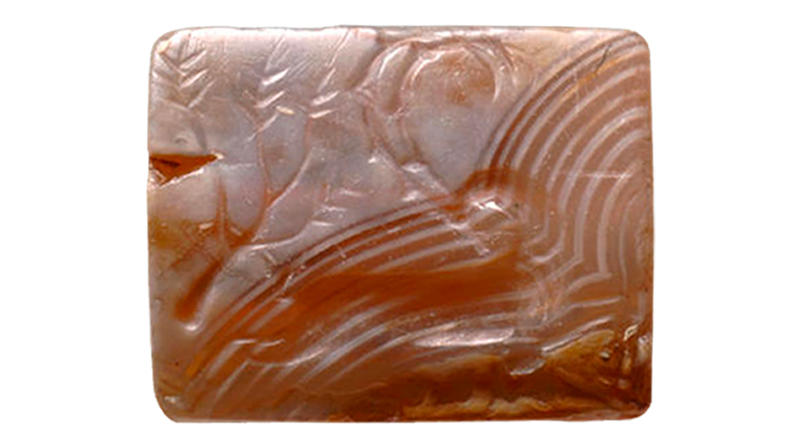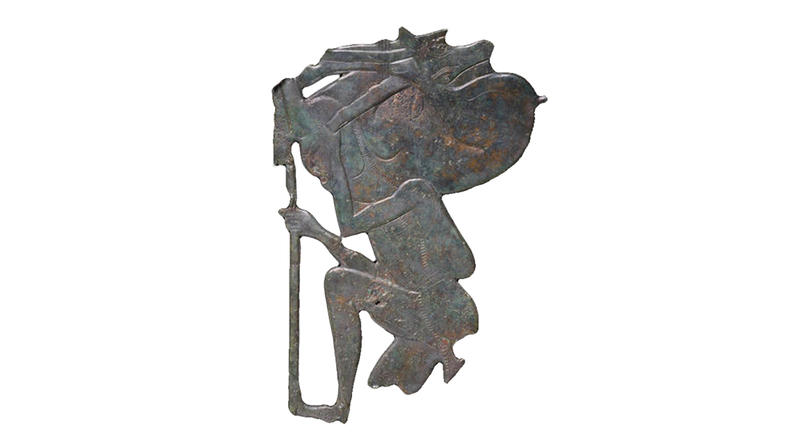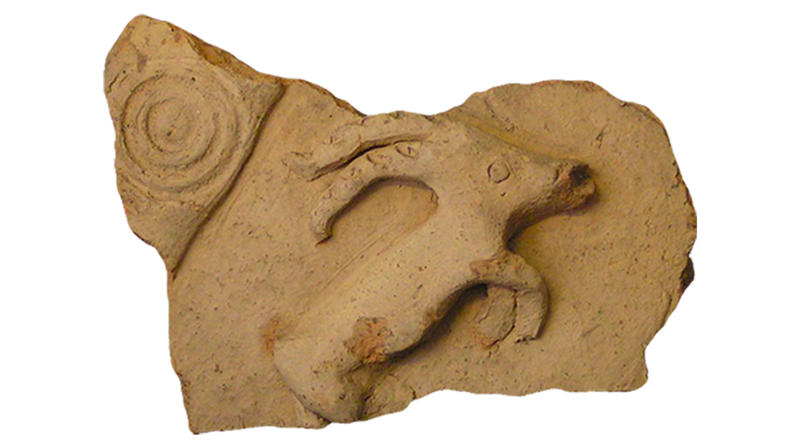GOATS ON THE LOOSE
10 minute read
By Andrew Shapland
Sir Arthur Evans Curator of Bronze Age and Classical Greece
As the mountain goats reclaiming the streets of Llandudno become celebrities, it is interesting to look at some other depictions of wild goats in the Ashmolean’s collection.
CRETE

Agate sealstone with depiction of wild goats on rocks, 1900-1700 BC. Diameter 1.35cm. AN1938.934
In all of the collections at the Museum, you’re unlikely to find more depictions of goats than in our objects from Crete. Wild goats, also known as agrimia or kri-kri, still roam the mountains of West Crete. Known for their long, knobbly curving horns and their agility, they have become a symbol of Crete, and many tourists travel to the Samaria Gorge National Park to try to catch a glimpse of them. A tiny sealstone from the early second millennium BC shows that these mountain goats were also important to the people of Bronze Age (Minoan) Crete. Such sealstones were used like signet rings, probably worn around the wrist or neck and then stamped in clay as a form of signature.
DOMESTICATION
When humans settled on Crete in around 7000 BC, they brought with them domestic plants and animals, including wheat and barley, and cattle, pigs, sheep and goats. From around 10,000 BC, the start of the Neolithic period, humans started to control the movement and breeding of wild goats, leading to their domestication. This domestication process happened to a number of plants and animals in the Middle East, and by the time the first farmers came to Crete, the whole ‘domestic package’ had been established.

Agate sealstone with a depiction of a wild goat with long knobbly horns, 1700-1600BC. Length 1.9cm. AN1938.946
DESCENDANTS

Chalcedony sealstone with a depiction of a wild goat and hunting dog, 1700-1600BC. Length 1.5cm. AN1938.954
Most domestic goats are descended from the bezoar ibex from the Zagros mountains, which run from southern Turkey to Iran. The bezoar ibex with its curving horns, white body and black shoulder stripe looks a lot like the Cretan wild goat. Recent DNA testing of Cretan wild goats has shown that, despite appearances, they are descended from early domestic goats. A number of these Neolithic goats seem to have escaped, or had been left to roam in the mountains and established a breeding population. The mountain goats of the Great Orme Country Park, now munching on the hedges of Llandudno, are also descended from a captive herd, once kept at Windsor. Their ancestors are likely to have been another type of wild goat, the markhor of Central Asia. The mountain goats of Wales and Crete are often described as ‘feral’ to indicate that they are neither wild or domestic; in reality, these simply indicate points along a spectrum of human control. The Cretan wild goats are protected from hunting in the area in which they live, the Samaria Gorge, a national park, but they are left to roam freely.
HUNTED
In Bronze Age Crete, there is evidence that these wild goats were hunted. Another sealstone in the Ashmolean collection shows a dog (wearing a collar, if you look closely) keeping a goat at bay. Other sealstones show goats with spears in their back. Before modern weapons, hunting agrimia would have been a dangerous activity, involving, as the image shows, a pursuit through rocky mountains . This is probably the reason someone would want to have this image on their personal sealstone – to show their skill and bravery.

Bronze plaque from Psychro Cave showing a man carrying a wild goat, c. 650 BC. Length 9.7cm. AN1896-1908.G.438
FOOD

Pottery vessel fragment showing a wild goat in relief, 1900-1600 BC. Length 19cm. AN1896-1908.AE.273
There is evidence from the Bronze Age and later periods that wild goats were eaten ceremonially. The remains of wild goats were found at a site called Psychro Cave, and also this plaque dating to around 650 BC, which shows a man carrying a goat, presumably for eating at one such ceremony – the image was left as an offering in the Cave, perhaps as a reminder of such a contribution. A fragment of a pot from the same site, made about 1000 years before, also shows a goat in relief, with the distinctive horns suggesting a wild animal. Wild goats were frequently shown in Bronze Age and later Crete, presumably because of the importance of hunting and eating them. Psychro Cave is in East Crete, which tells us that goats had a much wider range than they do now.
HORNS
The horns of wild goats were widely used in everyday life. This Linear B tablet from the Palace of Knossos, from around 1375 BC, shows that they were collected as taxation. The sign for horns appears on the bottom row, and 24 had been collected. These were likely to have been used to make bows: the Trojan hero Pandarus uses a bow made out of the horns of a wild goat in the Iliad.
The wild goats of Crete, and even the goats of Llandudno, show how domesticated animals can elude human control and thrive in the mountains for many years, as different societies come and go.

Burnt clay Linear B tablet showing commodities including wild goat horns. Length 13.2cm. AN1910.217




